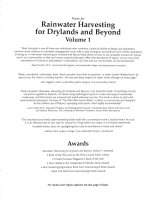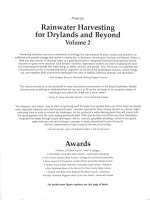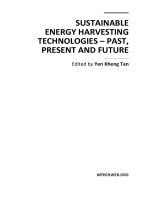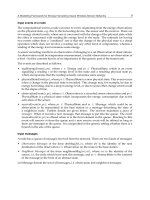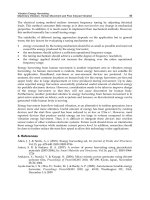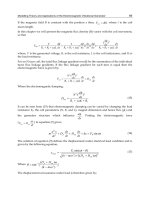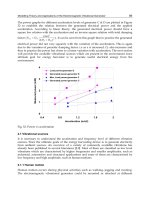HARVESTING ANTS AND TKAPDOOE SPIDERS.
Bạn đang xem bản rút gọn của tài liệu. Xem và tải ngay bản đầy đủ của tài liệu tại đây (9.75 MB, 200 trang )
(Ir-^
BY THE SAME AUTHOR.
Eoyal 8vo.
In 4 parts, each, with 25 Coloured Plates,
15s.,
or complete
in one vol. 63».
CONTEIBUTIONS TO THE FLOEA OF MENTOKE,
WINTER FLORA OF THE RIVIERA,
Including the Coast from Marseilles
to
Genoa.
BY
J.
L.
REEVE &
TEAHEENE MOGGEIDGE,
CO.,
5,
F.L.S.
HENRIETTA STREET, CO VENT GARDEN.
HARVESTING ANTS
AND
TKAP-DOOE SPIDERS.
:
HARVESTING ANTS
AND
TRAP-DOOR SPIDERS.
NOTES AND OBSBEVATIONS ON THEIE
paMts rab
J.
gfatllxtrgs*
TRAHERNE MOGGRIDGE,
F.L.S,
LONDON
L.
REEVE &
CO.,
5,
HENRIETTA STREET, CO VENT GARDEN.
1873.
:
LONDON
SAVILI.,
EDWARDS AND
CO.,
PRINTERS, CHANDOS STREET,
COVENT GARDEN.
CONTENTS.
PART
1.
PAGE
HARVESTING ANTS
1
PART
TEAP-DOOR SPIDERS
11.
71
EXPLANATION OF PLATES.
PART I.— HARYESTING ANTS.
—
Plate
I., p. 21, fig. A.
View of the entrance to a nest of Atta barbara,
showing part of a train of ants bearing seeds, the conical mound of
refuse thrown out, and some seedlings, which have sprung up from
seeds accidentally dropped by the ants B, one of the larger workers of
this species, of the natural size, andB 1, its abdomen and pedicle, with
two nodes, magnified C*, one of the smaller workers, of the natural
size ; C, a male, of the natural size
D, a female, of the natural size
D 1, wing of the same, magnified; I) 2, mouth organs of the same,
magnified, with the mandibles removed, the two outer pieces being the
maxilhie and their palpi, and the lozenge- shaped piece the labium, from
the upper part of which the labial palpi spring, while behind the labium
is the true tongue ; D 3, one of the mandibles, magnified ; E, a larva,
of the natural size, and E 1, the same, magnified.
;
;
;
Plate
full
A.
II., p. 22, fig.
—A
;
trowel containing earth, in which a granary
of seeds is lying almost undisturbed, of the natural size
crater-like entrances
found at the mouths of the nests
reduced to one-half the natural
;
B, the
of Atta str actor,
size.
—
Plate III., p. 23. The floors of three granaries of Atta barbara, surrounded
by the much coarser gravelly earth, of the natural size.
Plate
IV., p. 31.
—A
{Atta barbara)
were
seeds
full of
Plate V.,
mass of earth pierced by roots, in which the ants
have made their gi-anaries and galleries. The galleries
p. 33, fig.
when
A.
first laid
— Galleries
open.
Of the natural
and terminal
cells
barbara, excavated in the living sandstone rock,
natural size
and
B
1,
;
size.
of a nest of Atta
drawn
in
situ, of
the
B, part of a cylindrical gallery from another rock-nest,
the same gallery seen in front, of the natural
size.
—
Plate VI., p. 35, fig. A. A sprouting hempseed, part of the radicle of
which has been gnawed by the ants, of the natural size A 1, the same,
;
magnified,
magnified
gnawed
;
A
an entire sjjrouting seed of the same,
B, a sprouting pea, part of the radicle of which has been
rad.
off;
B
radicle
1,
;
2,
the same, magnified;
B
2,
the same stripped of
its
—
;;
EXPLANATION OF PLATES.
and showing the two seed leaves; C, a sprouting "canary-seed"
part of the fibril of which has been
gnawed off; CI, the same, magnified, rad. the radicle which remains
tmdeveloped, and /6. the fibril or first rootlet; C 2, an unmutilated
sprouting " canary seed ;" D, a mass of earth taken out of the heart of
a nest of Atta barbara, in which a spherical cell, made of hardened
It contained grass seeds, among which 1 found ants
earth, was buried.
at work, and seeds of the same grass still in their husks lay in the gallery
coat,
(the grain of Phalaris canarioisis)
,
D 1, the same, further freed
leading up to the entrance of this cell
from the earth, and having part of one side removed, so as to show the
;
and the small lower opening leading out from the bottom
interior
the
PART
Plate
of
cell.
VII., p. 88,
which
is
II.— TRAP-DOOR SPIDERS.
fig.
A.
—The nest
of Cteniza fodiens, the lower part of
seen in section lying in the earth, the door
is artificially
repre-
A
sented as partly open;
1, surface of the door viewed from above;
3, the spider deprived of its legs, from a specimen
2, the spider
preserved in spirits [figs. A,
1,
2, and
3, are of the natural size]
5, the eyes,
4, the spider viewed sideways, with the legs removed ;
viewed from above and in front
6, the cephalothorax and falces
A 7, the left hand falx, viewed from the inner side ; A 8, the fang of
A
;
A
A
A
A
A
A
;
the same
A
A
1), the tarsal joint of the
;
the two larger and the smallest claw
Fig. B, the
9, and 10, all magnified].
concealed by lichens, below which, on
A
A 4,
foremost right leg
of the
same
[figs.
;
10,
one of
5, 6, 7, 8,
door of a nest of the same kind,
the left hand, the doors of two
miuute nests of Nemesia meridionalis are seen ; B 1, the same, with the
doors open ; C, the door and mouth of tube of a nest similar to that at
; C 1, the upper surface of this door, which is slightly convex.
A
—
The nest of Nemesia ccvmentaria ; A 1, the
p. 94, fig. A.
door of the same, partially open;
2, the spider; A 3, the same
deprived of its legs, from a specimen preserved in spirits [figs. A, A 1,
2, and 3, of the natural size]; figs. A 4, 5, 6, 7, 8, 9, and 10 as in Plate
VII., and magnified B, a moss-covered lump of earth, in which the door
B 1, the same,
of a nest of the same type as that at A lies concealed
with the door open ; C, the door and mouth of another similar nest,
showing the claw marks on its imder surface D, the closed door of a
third nest of the same kind ; D 1, the same, opened.
Plate VIII.,
A
;
;
;
Thenestof Nemesia meridional is; A 1, the open sursame A 2, the inner and upper
surface of the lower door A 3, the spider A 4, the same deprived of
its legs, from a specimen preserved in spirits [figs. A, A 1, 2, 3, and 4
Plate IX.,
p. 98, fig.
face-door and
A.
mouth
of the tube of the
;
are of the natural size]
;
A
;
;
5,
the spider viewed sideways, with the legs
;
;
EXPLANA TION OF PL A TES.
removed
;
A
xi
the eyes, viewed from above and in front
6,
A
;
A
the
7,
the left hand falx viewed from the
inner side;
10, the tarsal joint of the
9, the fang of the same;
foremost right leg; All, one of the two larger and the smallest claw of
B, a mass of
the same [figs.
5, 6, 7, 8, 9, 10, and 11, magnified]
ce])halothorax and falces;
8,
A
A
A
;
earth containing the minute nest of a young spider (A'', mcridionalis) ;
B I, the lower door of this nest; B 2, the spider [figs. B, B 1, and 2,
of the natural size].
Plate X.,
A.
p. 100, fig.
— Part of a nest of N.
mcridionalis ; B, the new and
with the former and smaller
C, another example of enlargement in
showing traces of two previous doors
larger upper door of a nest of this spider,
upper door partially united to it
the upper door of the same spider,
;
DOW
Plate
[All the figures are of the natural size.]
incorporated.
XI,, p. 105,
fig.
A.
— The upper part of a nest of
closed and open,
A
N. meridionalis con-
and A 2, a minute cork-door,
saw constructed by a very young spider [either
cealed in a plant of Ceterach fern
;
1
which I
more probably, Nemesia ccementaria]
Cteniza fodiens, or,
at the
mouth
of a
hole in the mass of earth containing the nest of N. meridionalis figured at
A.
may
This hole
be seen on the right of the fern.
B, the door of a
small nest of N. meridionalis, as seen from above, in its natural position
in a steeply sloping bank
B I, part of the same nest placed in an upright
;
and showing the surface door open and the lower door closing
the branch j B 2, the same with the lower door pushed across so as to
close the main tube
B 3, 4, and 5, different views of this second door.
position,
;
[All the figures in this plate are of the natural size. ]
—
Plate XII.,
The nest of N. Eleanora with the surface
p. 106, fig. A,
door artificially represented as being open
1, the outer side of the
surface door of the same nest into which mosses of two kinds are woven
3, the spider
4, the same
2, the second door of the same nest
deprived of its legs, from a specimen preserved in spirits [figs. A,
1,
fig. A 5, the spider viewed sideways,
2, 3, and 4 are of the natural size]
with the legs removed A 6, the eyes viewed from above and in front
8, the left-hand falx viewed from
7> the cephalothorax and falces
;
A
;
A
A
;
A
A
;
;
A
;
A
A
A
the inner side
10, the tarsal joint of the
9, the fang of the same
foremost right leg A 1 1 one of the two larger and tlie smallest claw
of the same [figs. A 5, 6, 7, 8, 9, 10, and 11, magnified]; fig. B and
B 1 the upper part of the tube and door of a nest of N. Eleanora
which partially projected beyond the surface of the earth and was clothed
;
;
;
,
,
with living moss.
[Figs.
B and B
1
are of the natural size.]
PART
I.
HARVESTING
ANTS.
PART
I.
HARVESTING ANTS.
It was
in
presidential
May, 1869, that Mr. Bentbam
address
attention to the
to
the
want of
in his
Linnean Society
reliable
called
information as to
the existence of such subterranean accumulations of
seeds
as
are
popularly supposed to account for the
sudden appearance on railway cuttings, gravel from
deep pits, and the like, of crops of weeds hitherto
unknown
He
in a district.
suggested that
it
might repay the trouble
if
some accurate observers were to take this in hand,
and investigate the matter both by examining samples
of undisturbed soil taken from various depths,^ when,
if any seeds of moderate size were present and undecomposed, it would be tolerably easy to distinguish
and also by ascertaining what means of
them,
transport exist by which seeds may be scattered
over exposed surfaces, and thus explain the difficulty
—
—
without having recourse to liypothetical supplies of
sound though long-buried seeds.*
* M. Kerner of Innspruck has lately adduced some facts bearing on the
question of the transport of seeds by the wind, having examined the collections of animal and vegetable substances found on the icy surfaces of glaciers
and the plants growing on moraines. Judging from the facts thus obtained,
he attributes but a small influence to this agency, as the specimens dis-
B 2
HARVESTING ANTS,
4
As
I listened, the question occurred to
me whether
the ants, which I had observed carrying seeds to their
Mentone, might not be unconscious agents
on a small scale, both in the distribution and the
nests at
When at a later
subterranean storing of seeds.
time I made this suggestion to some of our leading
naturalists, I learned
with considerable surprise that
the unanimous opinion of our highest modern autho-
on the subject is opposed to the belief that
European ants ever do systematically collect and
make provision of seeds, and that the instances of
such occurrences in tropical climates remain as isolated
rities
thouq-h undoubted facts which
it
is
difficult to
ex-
plain.
I was not then aware that towards the middle of
last
century the ancient
belief,
dating from the time
of Solomon, that ants habitually show forethought
and husbandry in the collection of supplies of seeds
and grain had begun to be called in question, and
that our most able observers, such as Huber, Gould,
Kirby and Spence, and at the present day Mr.
Frederick Smith, had by close scrutiny of the habits
of these
creatures
proved that,
investigation had enabled
them
wherever personal
to put
the matter
to proof, no trace of harvesting was found.*
covered belonged to the fauna and flora of the immediate vicinity, and not
one of these specimens must needs have come from a distance. See alistvact
of his pajjer in Gardener's Chronicle, Feb. 3, 1872, p. 143, and in 'Nature' for
June
27, 1872, p. 164.
* I have myself on many occasions thrown seeds in the track of the common English ants, and my experience was, up to the past summer (1872),
similar to that of the above-named naturalists, but I have lately, by the
merest chance, become acquainted with a curious exception to this rule. It
happened as follows. I was gathering some fresh capsules of the common
sweet violet in a garden at Richmond, near London, and in pouring the seeds
5
HARVESTING ANTS.
However, just
as the ancient writers,
judging from
experience and from the reports of others,
had erred in attributing to ants in general the habit
their
own
of seed-storing possessed by certain species
have modern
found in the south, so
into the mistake of denying
it
to
commonly
naturalists fallen
any of the European
species.
The
older authors
who
lived in Greece
and
Italy,
and the mediseval authors who drew their information
in great measure from the former, being familiar
with the fact that some ants habitually collect large
supplies of seed, went so far as to assert, or to imply,
that all European ants do so; the authors of the
present day, on the other hand, generalizing too
freely from their experience of ants found near their
northern homes, maintained and maintain the very
reverse.
So long as Europe was taught natural history by
southern writers the belief prevailed but no sooner
;
them, a few were spiUed
out of my hand into the paper hag made to receive
surprised to see
on the ground. In a short time afterwards I was greatly
common black
some of these spilled seeds in motion, being carried by the
to get some
hastened
I
this
seeing
On
nest.
its
into
nig>a)
ant (Formica
taken from ant 3
more fresh violet seeds, and also a quantity of seeds
other seeds had lam.
granaries at Mentone, and scattered these where the
were carried in, but
After watching for half an hour a few of the violet seeds
were examined
these
though
removed,
was
seeds
granary
not one of the
disrepeated this experiment twice afterwards on a
with some curiosity.
I
same kind and obtained exactly the same result.
colony on the day after they had carried in
former
the
of
nest
I opened the
other seeds.
the seeds, but failed to find these or any stores of
these seeds believing them to be
I am incUued to think that the ants took
for fresh seeds of violet are not
larvffi of other ants which they might eat
example, those of Aita barbara,
for
as,
ants,
certain
of
larva
very unlike the
tinct colony of ants of the
;
membranous appendage
Plate I., Fig. E.. p. 21, the semi-transparent
fleshy appearance.
partly concealing the seed and giving it a
two occasions the seeds which had
I think this the more likely because on
ficrured at
out by the
been carried into the nest were subsequently thrown
had I believe discovered their mistake.
ants,
which
—
:
:
HARVESTING ANTS.
6
did the tide begin to turn, and the current of infor-
mation to flow from north to south, than the story
became discredited.
It
is
interesting
now
to the harvesting ants
to recal a few of the allusions
made by ancient
authors,
of which contain tolerably accurate accounts of
was
to
them
some
what
a familiar sight or a universally accepted
fact.
The
passages in Proverbs* are the following
to the ant, thou sluggard
wise
;
:
:
"
Go
consider her ways and be
which, having no guide, overseer, or ruler, pro-
videth her meat in the summer, and gathereth her
" The ants are a people not
food in the harvest."
strong, yet they prepare their
meat in the summer."
Hesiodf speaks of the time
" When the provident one
OTi
r' icfjOif
(the ant) harvests the grain."
awpov
df^arai.
Horace I also alludes to the foresight of the ant, who is
*'
haudignara ac non incauta futuri." Virgil § compares
the Trojans hastening their departure to harvesting
ants, and the passage has been thus rendered by
Dryden
:
The beach is covered o'er
With Trojan bands, that blacken all the shore
On every side are seen, descending down.
'
'
Thick swarms of soldiers, loaden from the town,
Thus, in battalia, march embodied auts,
Fearful of winter, and of future wants,
* vi. 6-8 and xxx. 25.
+ Works and Days, 776.
X Satires
§ ^neid, Bk. iv. I. 402.
"
Ac
I. i.
33.
velut ingentem formicae farris acervum
Quum
populant, hiemis memores, tectoque reponunt
nigrum campis agmen, pra?damque j^er herbas
Convectant calle angusto pars grandia trudunt
Obnixffi frumenta humeris ; pars agmina cogunt,
Castigantque moras ; opere omnis semita fervet."
It
;
'
HARVESTING ANTS.
?
T' invade the corn, and to their cells convey
The plundered forage of their yellow prey.
The sable troops, along the narrow tracks,
Scarce bear the weighty burden on their backs
Some set their shoulders to the ponderous grain
Some guard the spoil ; some la?h the lagging train
;
;
AU
Indeed,
it
ply their several tasks, and equal
would seem that among the people
shores
habiting the
common
almost as
;
toil sustain."
of the
Mediterranean
it
in-
was
to say " as provident as an ant
with us to say " as busy as a bee." Plautus*
introduces a slave who, when attempting to account
as
it is
for the rapid disappearance of a
which he had charge,
sum
si
money
of
says,
" Confit
Quam
of
cito
tu objicias formicis papaverem."
" It vanished in a twinkling,
Just like poppy seed thrown to the ants.
'
Any
one
who has
seen the eagerness with which
certain southern ants seize
upon seeds thrown
in their
path will appreciate the correctness of this simile.
Claudius Ji^lianus, who lived in the time of Hadrian,
gives a detailed account of the habits
which he
attri-
butes to ants,t from which the following is a translation " In summer time, after harvest, while the ears
are being threshed the ants pry about in troops around
:
leaving their homes, and going
They
three together.
sometimes
singly, in pairs, or
then select grains of wheat or barley, and go straight
the threshing
home by
others to
floors,
way they came. Some go to collect,
carry away the burden, and they avoid the
the
one another with great politeness and consideration, especially the unburdened for the weight
way
for
* Trinummus, Act ii. sc. 4, 1.
f ,^ian, De Natura Animalium,
7.
ii.
25.


